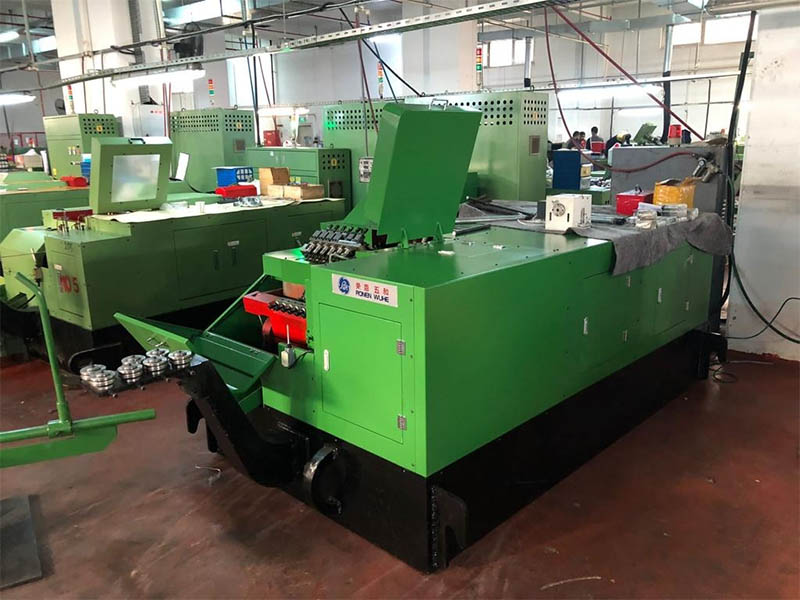
The Ronen®24B 6 Station Nut Former Machine, produced in our own factory, completes the shaping of the nut blank in six steps: wire cutting, extrusion, hexagonal forming, punching, edge trimming and final sizing. Set the size of the nut, and this factory-made machine can operate automatically, saving time.
The Ronen®24B 6 Station Nut Former Machine specifically forms the nut blanks through six consecutive cold extrusion stations. First, the steel wire is cut into sections, and then it is shaped at six different stations. Each workstation will further shape the nuts.
The selling point of nut former machine is that "its processing range is broader than that of smaller models." Cold heading forming produces almost no waste. A single wire can be utilized to over 95% of its capacity, which saves a considerable amount of material costs compared to using a cutting machine to cut the blank. Changing specifications is also quick. By adjusting the position of the molds at each workstation and the cutting length, production can start within one hour without the need to wait for a half-day for debugging.
Setting up the 24B 6 Station Nut Former Machine means that six sets of tools need to be installed. For each workstation, the corresponding punch and die must be equipped according to the specific nut size you want to manufacture. Once everything is ready, the machine can run the nut design for a long time.
When operating the nut former machine, the operator is mainly responsible for observing the entire process. You need to ensure that the wire feeder does not run out and check whether some of the finished nuts meet the size requirements. The machine itself performs the actual forming work.
The feature of 24B 6 Station Nut Former Machine is its durability and ease of maintenance. The body is made of thick cast iron. The transmission components at the six stations are all common types, and if they break, you can simply purchase the spare parts from any hardware store. The mold clamping block of the workstation has come loose. Just tighten it with a wrench twice.
| Specification | Unit | 11B | 14B | 17B | 19B | 24B | 27B | 30B | 33B | 36B | 41B |
| Forging Station | No. | 6S/7S |
6S/7S |
6S/7S |
6S/7S |
6S/7S |
6S/7S |
6S/7S |
6S/7S |
6S/7S |
6S/7S |
| Max Cut-Off Dia | mm | 11 | 15 | 17 | 19 | 24 | 28 | 30 | 33 | 36 | 41 |
| Kick-out Length | mm | 20/30/40 | 20/30/40 | 25/40/60 | 25/30/40/60/80 | 30/60/80 | 30/40/60/80 | 30/40/60/80 | 40/60/80/100 | 50/60/80/100 | 50/60/80/100 |
| Dies Pitch | mm | 50 | 60 | 70 | 80 | 100 | 110 | 120 | 140 | 150 | 165 |
| Forging Power | Ton | 60 | 90 | 110 | 135 | 230 | 260 | 300 | 360 | 420 | 650 |
| Production Size |
|
M3-M6 | M6-M10 | M8-M12 | M8-M14 | M10-M18 | M12-M18 | M14-M20 | M16-M22 | M18-M24 | M20-M27 |
| Output | min/pcs | 250 | 180 | 150 | 140 | 70 | 60 | 60 | 90 | 80 | 70 |
| Main Motor | Hp | 15 | 20 | 30 | 50 | 75 | 100 | 125 | 150 | 250 | 350 |
| Lubrication Motor | Hp | 1.5 | 1.5 | 1.5 | 1.5+3 |
1.5+3 |
1.5+3 |
1.5+3 |
1.5+3 |
1.5+3 |
1.5+3 |
| Lubricant | L | 700 | 1000 | 1100 | 1200 | 1700 | 2300 | 2000 | 2400 | 2400 | 2400 |
| Approx Weight | Ton | 4.5 | 8 | 11 | 14 | 25 | 38 | 42 | 45 | 70 | 73 |
